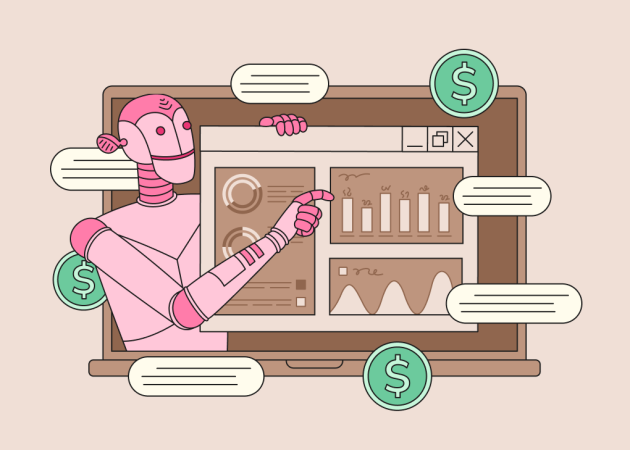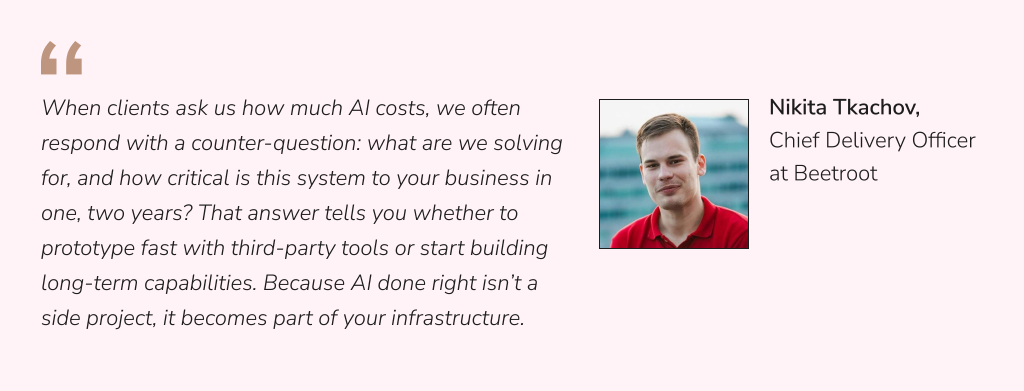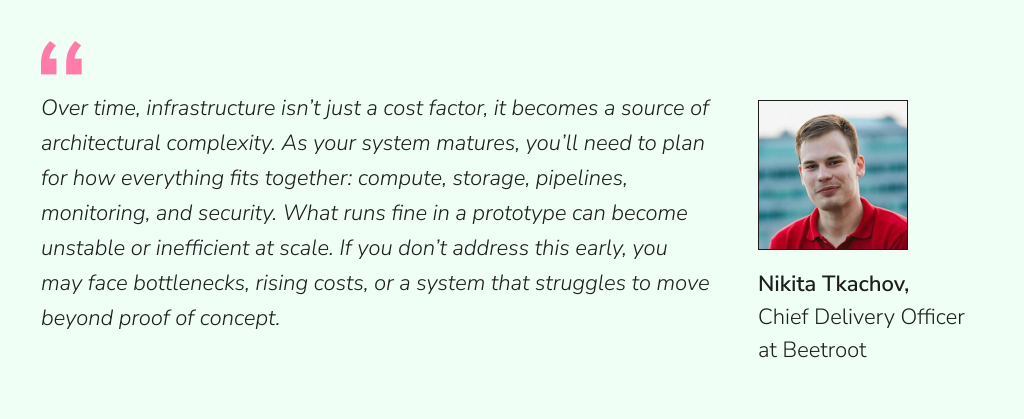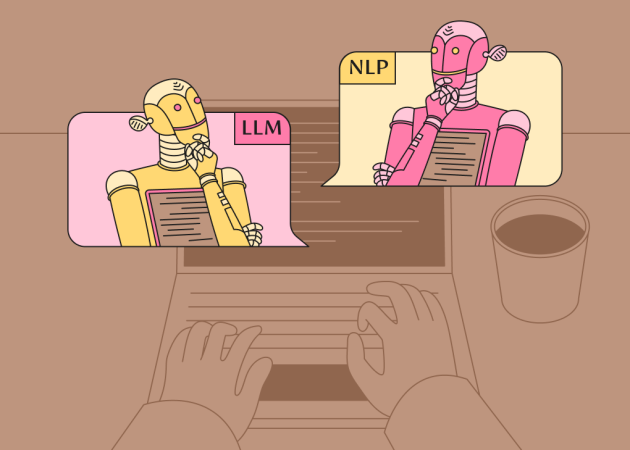
AI Development Costs Explained: What Actually Drives Your Budget Up
Contents
Contents
“How much will this cost us?” is a reasonable question and often the first thing decision-makers ask when exploring AI. The truth is, AI projects vary wildly in budget: from a few thousand dollars for a simple prototype to hundreds of thousands for a full-scale system. Yet while AI adoption has skyrocketed, many leaders still lack a clear view of the drivers that can ultimately push the AI development cost higher.
This article takes a closer look at the factors behind AI costs, giving you the context to make more informed decisions as you plan and budget your initiative.
Rethinking the Budget: Why “How Much Does AI Cost?” Often Misses the Point
With traditional software, the development lifecycle follows a linear path: plan, build, deploy, maintain. As a result, the cost of conventional IT systems is more stable and predictable. AI development, on the other hand, is cyclical and data-driven. Models drift, decay, underperform over time, and need retraining. Data pipelines need refreshes. What you’re building isn’t a static feature but a dynamic system that evolves alongside your business.
That’s why upfront cost estimates for AI tend to miss the mark. For tech leaders planning an AI initiative, it is crucial to understand what actually drives the work, from data readiness and infrastructure to long-term operations and scaling.
Off-the-Shelf vs Custom Solutions
When planning AI solutions, companies typically choose between three paths — each with its own cost profile, flexibility, and development timeline:
Off-the-Shelf Tools
Third-party AI tools, like OpenAI APIs or cloud-based AI services, offer a fast and budget-friendly way to get started. With subscription-based or pay-as-you-go pricing, you can often begin prototyping for as little as a few dollars a month. For early-stage projects or non-core features, this can be a practical, low-risk entry point. You avoid building models and infrastructure from scratch by using ready-made, production-tested tools. This reduces upfront investment and speeds up launch. The trade-offs include limited flexibility, ongoing usage fees, and less control over how your data is used or how the model behaves.
Semi-Custom Solutions
You might also choose a hybrid approach, starting with off-the-shelf tools and adding custom elements like business logic, UX, or infrastructure. Adapting an open-source model or integrating an AI component into your product can save time, since you’re not reinventing the wheel, but it comes with added development effort and cost.

Fully Custom Development
Custom AI solutions involve building and training models from scratch, often on proprietary data, and deploying them in infrastructure tailored to your use case. This route requires a larger upfront investment, including a tailored model, custom data pipelines, dedicated infrastructure, and significant time from expert talent. But it offers maximum control, adaptability, and, in many cases, lower operating costs over time, especially if AI is central to your product or operations. If that’s the direction you’re exploring, here’s how Beetroot approaches custom AI development.
Here’s a quick look at how all three options compare:
| Initial Cost | Flexibility | Scalability & Long-Term Cost | Best for | |
| Off-the-shelf tools (e.g. OpenAI APIs, cloud AI services) | Low | Low to moderate (limited customization) | Costs grow with usage (ongoing API fees) | Rapid prototyping, non-core features |
| Semi-custom solutions (e.g. custom wrappers around APIs, hybrid systems) | Moderate | Moderate (some control over logic and UX) | Balanced cost over time | Faster time-to-market with tailored output |
| Fully custom development (custom models, infrastructure, etc.) | High | High (full control over data, models, infra) | Higher upfront, lower at scale | Core systems, complex or sensitive use cases |
Project Complexity & Feature Set
The scope and complexity of your AI project are major determinants of cost. Several aspects of complexity can drive your budget up:
- Problem scope: Building a focused tool for a single use case typically involves fewer components. Expanding to a full-featured AI platform increases architectural complexity, cross-team effort, and overall development time.
- Algorithmic complexity: Simple ML models can be trained and deployed faster. Custom deep learning architectures require specialized talent, longer R&D cycles, and significantly more compute resources.
- Integration needs: Connecting your AI system to internal tools, third-party APIs, or legacy systems adds layers of development, testing, and long-term maintenance effort.
- Data preparation and validation: Working with large, unstructured, or inconsistent datasets means more time spent on cleaning, annotation, and quality checks.
- User experience requirements: Creating user-facing features like dashboards, custom interfaces, or visualizations involves dedicated UX design and front-end engineering to make AI capabilities usable and trustworthy.
It’s why the idea of a fully functional AI MVP for $5K often doesn’t hold up in practice. “Minimal” doesn’t always mean “simple”, especially when you’re working with sensitive data, edge cases, or production environments. Even early-stage builds can become expensive if they involve large volumes of data, custom pipelines, or real-time outputs.

Why Data Work Drives AI Development Cost?
Model performance depends heavily on the quality of your input data. If the data is inconsistent or poorly aligned with the problem you’re solving, the output will reflect that and fixing it often means revisiting the data itself, not just the model. Addressing this early can help you avoid expensive course corrections later.
At the same time, data remains one of the most underestimated cost drivers in AI development. In a 2022 survey, 72% of AI/ML professionals said they spend over half their time on data preparation, with more than a third spending 75% or more.
Here’s where the cost tends to build up:
- Collecting usable data: Finding or generating datasets that are relevant, high-quality, and representative of real-world use cases.
- Cleaning and labeling: Removing noise, correcting errors, standardizing formats, and annotating data with the level of detail your model requires, often with manual input.
- Data transformation and formatting: Converting diverse data sources into a consistent, usable structure for training and testing.
- Quality assurance and validation loops: Reviewing labeled data for accuracy, identifying inconsistencies, and running feedback cycles to catch errors before they affect the model.
- Maintaining data quality over time: Monitoring data drift and updating datasets as inputs evolve, systems scale, or use cases change.
As one of Beetroot’s machine learning engineers reflected on a recent project (name withheld due to NDA):
“Data work is the most underestimated part of AI projects. People often budget for model training but forget the weeks — often months — it takes to collect, structure, label, and validate datasets so they’re actually usable. It’s a hands-on, resource-intensive process, and it almost always takes more time than teams expect.”
Talent and Team Composition
Building an AI solution is a multidisciplinary effort that brings together cross-functional teams of:
- Data scientists: Experts who build and evaluate machine learning models, select appropriate algorithms, and define model objectives based on business goals.
- ML engineers: They operationalize and fine-tune models, optimize training and inference pipelines, and integrate them into production environments.
- Data engineers: Professionals who design and maintain data pipelines, ensure data availability and quality, and manage ETL processes for training and real-time inputs.
- DevOps / MLOps specialists: These engineers set up infrastructure for continuous integration, deployment, and monitoring; automate retraining and manage model versioning.
- Domain experts: Depending on your project, you might need to engage people with specific industry knowledge (e.g., healthcare, finance) to guide model assumptions, label data accurately, and evaluate results for business relevance.
- Product engineers: Front-end and backend developers, QA testers, and other experts who connect the AI component to the wider application logic and ensure it integrates seamlessly with the product’s architecture.
- UX/UI designers: Shape the user experience around the AI system, from dashboards to interactive features.
For companies not having this talent in-house, especially early-stage organizations or businesses new to AI, hiring skilled AI professionals can be challenging. Talent acquisition is often one of the largest budget items in the total cost of AI development, driven by the scarcity of AI specialists versus demand, compensation levels, and market competition. Moreover, to cover all necessary skill areas, you will need to assemble a well-rounded team.
That’s why many companies choose to work with AI development partners or consultancies who can quickly provide them with the needed tech capabilities and access to IT experts. At Beetroot, we bring together the right people and processes to design, build, and deploy AI solutions that align with your goals and help you move from concept to production faster, so you can focus on delivering impact.

Computing Infrastructure and Tools
Training and running AI models requires significant computational power, and infrastructure costs can scale quickly. You can rent compute capacity from cloud providers like AWS, Azure, or GCP, typically billed per hour of GPU usage or invest in on-premise hardware. Either way, costs rise with model complexity and data volume.
Whether you’re working with GPUs, TPUs, or managed cloud environments, compute resources accumulate fast, especially for generative AI solutions that rely on large models, continuous retraining, or real-time inference.
But compute is only part of the picture. Running a production-ready AI system requires a broader infrastructure stack to support experimentation, deployment, monitoring, and ongoing operations. As the system grows in complexity and maturity, these costs can increase substantially.
Here’s what typically contributes to infrastructure-related costs:
- Third-party API usage per output token (e.g., OpenAI, AWS, Google Cloud AI services) that tends to grow with the user base
- Software licenses and tooling for experimentation, versioning, and deployment
- DevOps and MLOps infrastructure, including CI/CD pipelines, model registries, and monitoring
- Data storage and bandwidth, especially for high-volume or multimedia inputs
- Inference costs, particularly if your system needs to respond in real time
- Security, compliance, and performance optimization layers, which can add overhead as your system scales
Integration and User Experience (Productization Costs)
A common misconception in AI development is treating the model as the end product. In reality, to deliver value and ROI, the model needs to be embedded into a user-friendly chatbot interface, supported by clear workflows, and integrated into existing systems.
Turning AI into a usable product often involves cross-functional collaboration between engineers, designers, product teams, and QA. This stage includes the effort to:
- Design and build web or mobile interfaces that present predictions clearly and intuitively
- Create dashboards for monitoring, transparency, and human-in-the-loop decision-making
- Develop APIs to connect AI models to internal tools, customer-facing apps, or third-party systems
- Build and maintain data pipelines that handle inputs and route outputs to where they’re needed
- Ensure integration with existing workflows, which often involves custom logic and orchestration
At this stage, you’ll also need to reconsider testing. AI-driven features don’t always behave predictably, they react to changing inputs, evolve over time, and depend heavily on data quality. That means your QA process won’t just check for basic functionality. You’ll need to test for performance, edge cases, fairness, and how the system affects user trust. You can expect more iteration, longer testing cycles, and closer collaboration across teams.
All of this contributes to the total cost of artificial intelligence model — not just a proof of concept. Ignoring the UX and integration layer early on is among the reasons why AI projects stall before launch.

Regulatory Compliance and Security
Compliance and security often take a back seat in the early stages of AI development, but they can become major cost factors, especially in regulated sectors like healthcare, finance, or government. If your system deals with personal data, supports critical decisions, or runs in high-risk environments, the legal and security requirements can quickly expand the cost of implementing AI.
Security hardening and regulatory compliance can involve:
- Data privacy controls to comply with regulations like GDPR, HIPAA, CCPA, or the EU AI Act
- Bias detection and mitigation to avoid discriminatory outcomes in areas like credit scoring, hiring, or healthcare recommendations
- Auditability and explainability to ensure your models can be understood, justified, and challenged when needed
- Access management, encryption, and secure infrastructure to protect both data and model assets
- Documented policies and risk assessments, often required for internal review or external certification
These aren’t one-time tasks, they require ongoing attention, updates, and coordination across legal, engineering, and security teams. Even if your current use case isn’t tightly regulated, building with future compliance in mind can prevent painful rework as your product scales or moves into new markets.
The cost of overlooking compliance isn’t just technical, it’s reputational and financial. Systems that lack transparency, fairness, or security can trigger regulatory scrutiny, limit adoption, or erode user trust. If there’s any chance your AI system will be used in high-stakes or sensitive environments, it’s worth investing in these safeguards from the outset.

Ongoing AI Maintenance and MLOps
Building your AI MVP is just the beginning. Once the model is in production, you’ll need to think about ongoing maintenance, from retraining and monitoring to infrastructure updates. This is an often underestimated cost driver.
Over time:
- Models drift as real-world data evolves, reducing accuracy
- Infrastructure needs change as usage grows or tech stacks evolve
- New data flows in, requiring updates to pipelines, storage, and validation logic
To keep performance stable and the system reliable, you’ll need to budget for:
- Model monitoring and retraining to catch drift and maintain accuracy
- Data pipeline maintenance to keep inputs clean and flowing
- Bug fixes and incremental improvements based on real-world usage
- Platform and infrastructure upgrades as the system scales
- Ongoing support and operations, including MLOps tooling and staff time
This is part of the AI lifecycle. As Beetroot’s CDO, Nikita Tkachov, explains,
”Mature AI systems require the same kind of operational planning as any critical software service. A good rule of thumb is to allocate 10–20% of your initial development budget annually for maintenance, depending on the complexity of your system and how fast your data environment changes. Failing to plan for this often results in degraded model performance, rising technical debt, or unexpected firefighting, all of which can erode trust in the system and stall adoption.”
Conclusion: Planning for Long-Term Impact
AI app development costs don’t come from a single source, they build up across decisions about scope, data, infrastructure, team structure, and long-term strategy. It’s not just about training a model. It’s about building something your team can rely on, something that delivers value in the real world and continues to perform as your needs evolve.
You’ll get the most long-term value by investing in:
- Defining clear, achievable goals
- Preparing high-quality, usable data
- Bringing in the right talent at the right time
- Choosing scalable infrastructure from the start
- Working with partners who understand both the tech and the bigger picture
At Beetroot, we help you scope smartly and build responsibly, with the right balance of technical depth, business context, and long-term thinking.
FAQs
What factors drive up the cost of AI development?
AI development costs often stem from what it takes to support, scale, and integrate the solution, not just building the model. Key drivers include the complexity of the problem, data quality and availability, model architecture, required integrations, and the need for specialized talent or custom tooling. Frequent iterations and unclear scope can also push costs up quickly.
What hidden costs should I plan for in an AI project?
Some of the major cost drivers won’t show up in early estimates. You’ll likely need to account for cleaning and labeling training data, managing edge cases, and preparing for evolving regulations. Time and resources can also go into aligning stakeholders, conducting compliance reviews, and updating models as your data changes. These may not be obvious at the start, but they’re a part of making AI work reliably in production.
What ongoing maintenance costs should I expect after deploying an AI system?
Ongoing costs often include model monitoring, updates, retraining, performance tuning, and infrastructure usage, especially in cloud environments. Depending on the use case, the system may also require regular adjustments to stay accurate as data, user behavior, or business needs change.
How can I reduce AI development costs without sacrificing quality?
If you’re looking to keep AI development costs under control, start by defining a specific problem and aligning your team on what the system needs to accomplish. A clear scope helps you avoid unnecessary complexity and rework down the line. You can move faster by relying on proven models or frameworks and validating early with users. In many cases, the most expensive AI projects are the ones that drift due to unclear priorities or misalignment across teams.
Is it more cost-effective to build an AI solution in-house or outsource it?
There’s no one-size-fits-all answer. Building in-house gives you more control long term, but it also means hiring and retaining AI talent, building internal processes from scratch, and taking on the full operational load. Working with a partner can help you move faster, avoid common pitfalls, and tap into cross-functional expertise without the overhead. The right call depends on your internal capabilities, timeline, and how central the AI solution is to your core business.
Subscribe to blog updates
Get the best new articles in your inbox. Get the lastest content first.
Recent articles from our magazine
Contact Us
Find out how we can help extend your tech team for sustainable growth.







